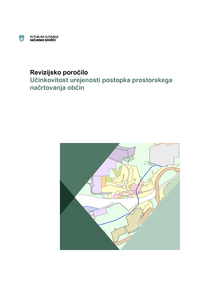The Court of Audit of the Republic of Slovenia carried out a performance audit to examine whether the Ministry of the Environment and Spatial Planning ensured the efficient municipal spatial planning procedure and carried out all tasks conferred to it in accordance with the Spatial Planning Act. It also examined whether the Ministry of the Environment and Spatial Planning, the Ministry of Agriculture, Forestry and Food, the Ministry of Culture and the Institute of the Republic of Slovenia for Nature Conservation had sufficient personnel and processes as well as tools developed to issue opinions on municipal spatial plans within the deadlines as laid down in legal bases. The Court of Audit expressed the opinion that in the period from 1 January 2008 to 31 December 2015 (the period covered by the audit) the municipal spatial planning procedure was not efficient.
The ministry responsible for spatial planning was not efficient in regulating and arranging the spatial planning procedure of municipalities in the period covered by the audit. Not all municipalities had spatial plans adopted, some not even started with their preparation. By the end of 2015, only 130 out of 212 municipalities already adopted their spatial plan although the deadline for the adoption as laid down in the applicable Spatial Planning Act expired in the middle of November 2009. Thereby the ministry responsible for spatial planning failed to provide incentives respectively impose sanctions to encourage municipalities to commence with or to conclude the spatial planning procedures, yet it enabled the municipalities to modify and supplement their spatial planning acts adopted in accordance with the regulations valid prior to the implementation of the Spatial Management Act which regulated the concerned field before the existing Spatial Planning Act.
The main indicator of inefficiency of the spatial planning procedure is its lengthiness as it elapsed on average more than 3.5 years or 1,315.6 days from submitting the first draft to adopting a municipal spatial plan. In this period, however, time spent by a municipality before drawing up a municipal spatial plan draft was not included, which additionally extends the total time required for the adoption of a municipal spatial plan. The ministry responsible for spatial planning failed to provide conditions enabling a comprehensive approach to spatial planning procedure as well as a comprehensive consideration of all existing interests with the purpose of implementing the principles of sustainable development. It also failed to ensure the mechanism for solving disagreements between a municipality and bodies responsible for spatial planning or among several bodies responsible for spatial planning which was, as in accordance with the opinion of the Court of Audit, one of the main reasons for time-consuming and extensive spatial planning procedures of municipalities.
The Court of Audit assessed that it would be appropriate to examine whether the Strategic Environmental Assessment (SEA) procedure could be more efficiently integrated into the spatial planning procedure of municipalities as the latter is significantly extended if the SEA procedure is required for the adoption of a municipal spatial plan. Furthermore, the Court of Audit assessed that the ministry responsible for spatial planning failed to timely include the public into spatial planning procedure of municipalities and to provide public with efficient legal protection.
The Court of Audit was of the opinion that the ministry responsible for spatial planning did not systematically identify reasons for time-consuming and extensive procedures of municipal spatial plan preparation and it failed to carry out all the tasks defined by Spatial Planning Act which could contribute to adoption of a municipal spatial plan, namely it failed to set up an information system with all its functionalities, which was planned to be completed already by the beginning of 2010. In addition thereto, the ministry responsible for spatial planning failed to draw up general guidelines on spatial planning, namely the national spatial plan which should have been prepared by 29 October 2007 and the National Spatial Order which should have been prepared by 29 July 2013.
Time-consuming and extensive procedure was also the consequence of coordination and harmonisation between municipalities and individual bodies responsible for spatial planning who consider municipal spatial plans partially respectively address only their area of competence. Tasks of the examined bodies responsible for spatial planning were in the period covered by the audit carried out by the ministry responsible for spatial planning (body responsible for housing), the subordinated body of the ministry responsible for environment (body responsible for waters), the ministry responsible for agriculture (body responsible for agriculture), the ministry responsible for culture (body responsible for culture) and the Institute of the Republic of Slovenia for Nature Conservation (body responsible for nature).
Based on the data on average time required by bodies responsible for spatial planning for the preparation of the opinions on the draft and the municipal spatial plan proposal, only the body responsible for nature issued opinions within legal deadlines as defined by Spatial Planning Act. As assessed by the Court of Audit, the aforementioned is mainly the result of decentralised organisation of the responsible body which improves mutual contacts and cooperation with municipalities and adds to better understanding of characteristics of individual areas. The body responsible for nature also encouraged, if required, inclusion of additional personnel for the purpose of municipal spatial plan consideration. Among audited bodies responsible for spatial planning the body responsible for nature most closely resembled the body responsible for culture in terms of its organisation. Nevertheless, in accordance with the data on average time spent for opinion preparation on the draft and municipal spatial plan proposal the body responsible for culture did not follow the similar response times as the body responsible for nature. The body responsible for housing, the body responsible for waters and the body responsible for agriculture were assessed to be less efficient as regards the organisation of issuing opinions on municipal spatial plans.
In addition to assuring the opinions on municipal spatial plans to be up-to-date, the Court of Audit pointed out the importance of their quality and comparability, providing for unification of different viewpoints towards incentives and unification of opinions on municipal spatial plans in terms of content adding to equal treatment of all municipal spatial plans. Standardisation of viewpoints regarding municipal spatial plans was ensured only by the body responsible for culture, while conceptual unification of opinions on municipal spatial plans was ensured by the body responsible for culture and the body responsible for nature.
All bodies responsible for spatial planning, except for the body responsible for housing, had protection regimes set up in their information systems, with the body responsible for culture being the only with IT support devised especially for the examination of municipal spatial plans. Additionally, all bodies responsible for spatial planning, except for the body responsible for housing, offered IT support for spatial planning to all municipalities.
The Court of Audit assessed that only the body responsible for nature carried out its tasks efficiently. The body responsible for culture carried out its tasks partially efficiently, the body responsible for housing, the body responsible for waters and the body responsible for agriculture carried out their tasks inefficiently.
The Court of Audit demanded from the Ministry of the Environment and Spatial Planning to submit a response report indicating corrective measures to remedy the established inefficiencies. The Court of Audit also proposed a series of recommendations to the Ministry of the Environment and Spatial Planning, the Ministry of Agriculture, Forestry and Food and the Institute of the Republic of Slovenia for Nature Conservation for improving efficiency.



